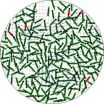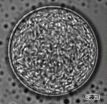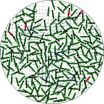(Press-News.org) VIDEO:
When confined in a water droplet, B. subtilis bacteria collectively and spontaneously form a swirling vortex, with some bacteria moving in one direction and others moving the opposite way. Researchers...
Click here for more information.
PROVIDENCE, R.I. [Brown University] — When a bunch of B. subtilis bacteria are confined within a droplet of water, a very strange thing happens. The chaotic motion of all those individual swimmers spontaneously organizes into a swirling vortex, with bacteria on the outer edge of the droplet moving in one direction while those on the inside move the opposite direction.
Researchers from Brown University and the University of Cambridge have explained for the first time how that dual-motion vortex is generated. Using computer modeling and a clever experiment, the researchers show that the fluid flow generated by all those tiny swimmers explains that strange two-way motion.
The research is published in Proceedings of the National Academy of Sciences.
Hugo Wioland and Raymond Goldstein from Cambridge first demonstrated the phenomenon experimentally in 2013. But at that time, the dynamics of the system — especially the two-directional motion — weren't fully understood. Enkeleida Lushi, now a postdoctoral researcher in Brown's School of Engineering and an expert in theoretical modeling, started thinking about this problem while at Cambridge on a fellowship last year.
"These are very simple organisms," Lushi said. "They do not consciously decide where to go and how to organize. Most of the dynamics occur just due to physical mechanisms, like collisions with each other and the boundary. But there was no intuitive way to explain what was happening with the dual-motion vortex. It was very puzzling."
The initial model attempting to reproduce the phenomenon focused on the mechanical interactions between individual bacteria. Those simulations showed that when individuals swimming in random trajectories start bumping into each other in a confined circular space, they tend to orient each other to the same angle relative to the circular boundary. That helps explain how a coordinated motion starts, but can't explain why individuals toward the outside of the circle move in the opposite direction from those on the inside.
That part of the phenomenon, it turns out, is a matter of fluid flow.
"These bacteria are only a few micrometers long," Lushi said. "At that scale, the fluid flow to them feels very viscous — very different from what we experience in air or even in water. The effect is that any movement that the bacteria make causes disturbances in the flow that will be felt strongly by their neighbors."
So Lushi and her colleagues developed a computer simulation that included the fluid flows created when the bacteria swim. B. subtilis swim by turning tiny corkscrew-like appendages called flagella. The flagellar bundle pushes against the fluid, which propels the bacteria forward and pushes the fluid in the opposite direction.
When Lushi included those dynamics in her simulation, the source of the two-way motion became clear. The bacteria all tend to align themselves facing in the same direction, the simulation showed. But individuals swimming along the outside of the circle created a flow in the fluid in the opposite direction from the direction they're swimming. Bacteria toward the inside of the circle are forced to swim against that flow, but can't quite keep up. They end up moving in the same direction as the flow — the opposite direction of the swimmers on the outside.
To confirm the model, the researchers set up an experiment with real bacteria, using colored dyes on the bacterium body and flagella to determine which direction the bacteria were facing. The experiment showed that all the bacteria were indeed attempting to swim in the same direction. But those in the middle were swept backward, apparently by the fluid flow created along the outside. It was just as the model had predicted.
"It's a very basic model," Lushi said, "but in the end it captures this phenomenon very well. It showed that any study of microbes suspended in a liquid should not ignore the motion of that liquid – it could have important repercussions on the microbes."
So why study the strange motion of bacteria in a water drop?
VIDEO:
When confined in a water droplet, B. subtilis bacteria collectively and spontaneously form a swirling vortex, with some bacteria moving in one direction and others moving the opposite way. Researchers...
Click here for more information.
"We want to understand nature where there are many incidences of independent individual units organizing collectively — these bacteria are but one example," Lushi said. "But also, we might want to eventually control these bacterial systems. Can we control the collective motion of bacteria in the human bodies so an infection doesn't spread? The more we understand them and how they move collectively, the better we can control their motion."
INFORMATION:
Editors: Brown University has a fiber link television studio available for domestic and international live and taped interviews, and maintains an ISDN line for radio interviews. For more information, call (401) 863-2476.
Emergence of bacterial vortex explained
2014-06-23
ELSE PRESS RELEASES FROM THIS DATE:
Straw albedo mitigates extreme heat
2014-06-23
Wheat fields are often tilled immediately after the crop is harvested, removing the light-coloured stubble and crop residues from the soil surface and bringing dark bare earth to the top. Post-harvest tilling is a widely practised and common management technique in Europe. However, ploughed fields can have a negative effect on the local climate during a heat wave. This effect was addressed in a recent study conducted by researchers at ETH Zurich led by Edouard Davin, senior lecturer at the Institute for Atmospheric and Climate Science, and Sonia Seneviratne, professor of ...
Vaccine made from complex of two malaria proteins protects mice from lethal infection
2014-06-23
WHAT:
An experimental vaccine designed to spur production of antibodies against a key malaria parasite protein, AMA1, was developed more than decade ago by scientists from the National Institute of Allergy and Infectious Diseases (NIAID), part of the National Institutes of Health. It showed promise in test-tube and animal experiments and in early-stage clinical trials, but returned disappointing results in recent human trials conducted in malaria-endemic countries.
Now, the NIAID scientists have improved on their original vaccine with a new candidate that delivers AMA1 ...
Rett syndrome drug shows promise in clinical trial
2014-06-23
CAMBRIDGE, MA -- Rett syndrome, a rare genetic disorder that causes mental retardation, autism, and physical deformities, has no cure. However, a small clinical trial has found that a growth factor known as IGF1 can help treat some symptoms of the disease.
Children who received the drug for four weeks showed improvements in mood and anxiety, as well as easier breathing, in a trial led by researchers at Boston Children's Hospital. MIT scientists first identified IGF1 as a possible treatment for Rett syndrome in 2009.
"This trial shows that IGF1 is safe in the cohort ...
New analysis reveals previously 'hidden diversity' of mouth bacteria
2014-06-23
MBL, WOODS HOLE, MA—A new computational method for analyzing bacterial communities has uncovered closely related, previously indistinguishable bacteria living in different parts of the human mouth. The technique, developed by Marine Biological Laboratory (MBL) scientists, provides high taxonomic resolution of bacterial communities and has the capacity to improve the understanding of microbial communities in health and disease. The study will be published in PNAS Online Early Edition the week of June 23-27, 2014.
An important step in understanding the role of oral bacteria ...
Computational technique provides new insight into oral microbiome
2014-06-23
CAMBRIDGE, Mass., June 23, 2014—Scientists have applied a new technique to comprehensively analyze the human oral microbiome—providing greater knowledge of the diversity of the bacteria in the mouth. For the first-time, scientists can provide high-resolution bacterial classification at the sub-species level. This work will enable researchers to more closely examine the role of bacterial communities in health and disease.
The study, "Oligotyping analysis of the human oral microbiome," will be published in the Proceedings of the National Academy of Sciences and available ...
Delivering drugs on cue
2014-06-23
June 23, Boston -- Current drug-delivery systems used to administer chemotherapy to cancer patients typically release a constant dose of the drug over time - but a new study challenges this "slow and steady" approach and offers a novel way to locally deliver the drugs "on demand," as reported in the Proceedings of the National Academy of Sciences (PNAS).
Led by David J. Mooney, Ph.D., a Core Faculty member at Harvard's Wyss Institute for Biologically Inspired Engineering and the Robert P. Pinkas Family Professor of Bioengineering at the Harvard School of Engineering ...
Bone loss persists 2 years after weight loss surgery
2014-06-23
CHICAGO, IL — A new study shows that for at least two years after bariatric surgery, patients continue to lose bone, even after their weight stabilizes. The results—in patients undergoing gastric bypass, the most common type of weight loss surgery—were presented Monday at the joint meeting of the International Society of Endocrinology and the Endocrine Society: ICE/ENDO 2014 in Chicago.
"The long-term consequences of this substantial bone loss are unclear, but it might put them at increased risk of fracture, or breaking a bone," said Elaine Yu, MD, MSc, the study's principal ...
A disease of mistaken identity
2014-06-23
The symptoms of Cushing disease are unmistakable to those who suffer from it – excessive weight gain, acne, distinct colored stretch marks on the abdomen, thighs and armpits, and a lump, or fat deposit, on the back of the neck. Yet the disorder often goes misdiagnosed.
To help combat misdiagnosis, Saleh Aldasouqi, an associate professor in the College of Human Medicine at Michigan State University, is drawing more attention to the rare disease through a case study, which followed a young patient displaying classic, yet more pronounced signs of the condition.
Caused ...
Date labeling confusion contributes to food waste
2014-06-23
Date labeling variations on food products contribute to confusion and misunderstanding in the marketplace regarding how the dates on labels relate to food quality and safety, according to a scientific review paper in the July issue of Comprehensive Reviews in Food Science and Food Safety. This confusion and misunderstanding along with different regulatory date labeling frameworks, may detract from limited regulatory resources, cause financial loss, and contribute to significant food waste.
In the United States, the United States Department of Agriculture Economic Research ...
Understanding the ocean's role in Greenland glacier melt
2014-06-23
The Greenland Ice Sheet is a 1.7 million-square-kilometer, 2-mile thick layer of ice that covers Greenland. Its fate is inextricably linked to our global climate system.
In the last 40 years, ice loss from the Greenland Ice Sheet increased four-fold contributing to one-quarter of global sea level rise. Some of the increased melting at the surface of the ice sheet is due to a warmer atmosphere, but the ocean's role in driving ice loss largely remains a mystery.
Research by scientists at Woods Hole Oceanographic Institution (WHOI) and the Univ. of Oregon sheds new light ...






